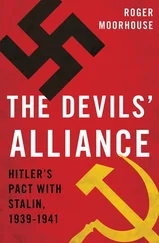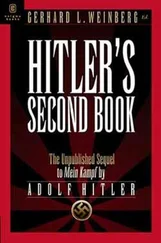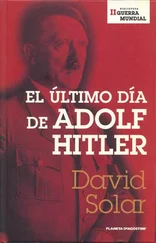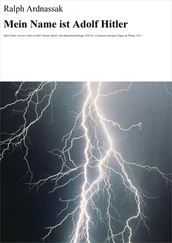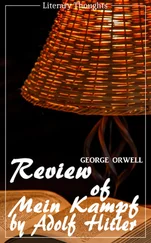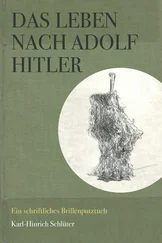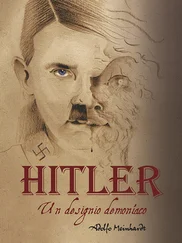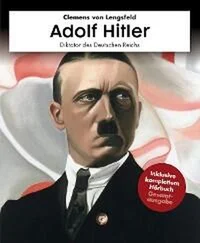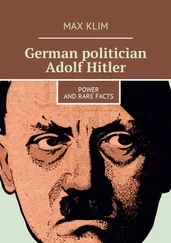Christa Schroeder - He Was My Chief - The Memoirs of Adolf Hitler's Secretary
Здесь есть возможность читать онлайн «Christa Schroeder - He Was My Chief - The Memoirs of Adolf Hitler's Secretary» весь текст электронной книги совершенно бесплатно (целиком полную версию без сокращений). В некоторых случаях можно слушать аудио, скачать через торрент в формате fb2 и присутствует краткое содержание. Город: Barnsley, Год выпуска: 2012, ISBN: 2012, Издательство: Frontline Books, Жанр: История, Биографии и Мемуары, на английском языке. Описание произведения, (предисловие) а так же отзывы посетителей доступны на портале библиотеки ЛибКат.
- Название:He Was My Chief: The Memoirs of Adolf Hitler's Secretary
- Автор:
- Издательство:Frontline Books
- Жанр:
- Год:2012
- Город:Barnsley
- ISBN:978-1-7830-3064-4
- Рейтинг книги:4 / 5. Голосов: 1
-
Избранное:Добавить в избранное
- Отзывы:
-
Ваша оценка:
- 80
- 1
- 2
- 3
- 4
- 5
He Was My Chief: The Memoirs of Adolf Hitler's Secretary: краткое содержание, описание и аннотация
Предлагаем к чтению аннотацию, описание, краткое содержание или предисловие (зависит от того, что написал сам автор книги «He Was My Chief: The Memoirs of Adolf Hitler's Secretary»). Если вы не нашли необходимую информацию о книге — напишите в комментариях, мы постараемся отыскать её.
He Was My Chief: The Memoirs of Adolf Hitler's Secretary — читать онлайн бесплатно полную книгу (весь текст) целиком
Ниже представлен текст книги, разбитый по страницам. Система сохранения места последней прочитанной страницы, позволяет с удобством читать онлайн бесплатно книгу «He Was My Chief: The Memoirs of Adolf Hitler's Secretary», без необходимости каждый раз заново искать на чём Вы остановились. Поставьте закладку, и сможете в любой момент перейти на страницу, на которой закончили чтение.
Интервал:
Закладка:
19
Albert Bormann (b. 2.9.1902 Halberstadt, d. 8.4.1989 Munich). Brother of Martin Bormann; joined NSDAP 27.4.1927; NSDAP Hilfskasse 12.5.1931; head of ‘Private Chancellery Adolf Hitler’ February 1933; from 1938 Reichstag deputy, 1934◦– 29.4.1945 personal adjutant to Hitler; in Bavaria then assumed the name Roth and worked as a farm labourer until 5.4.1949 when he surrendered to the authorities; interned; released 4.10.1949.
20
Although Schroeder may have thought him to be Herr Incorruptible, the ‘clean hands’ of Martin Bormann were the result of his personal devotion to the Nazi cause. In a letter to Hess on 5 October 1932 he summed up his attitude thus: ‘For me and all true National Socialists the only thing that matters is the Movement, nothing else. Whatever or whoever is useful to the Movement is good, whoever damages it is a parasite and my enemy.’ Bormann executed all Hitler’s orders faithfully and without question, never asking if they were right, humane or serving some useful purpose.
21
The Thule Society was a cornerstone of the Nazi Movement. The three co-founders were mystics. Guido von List (1865–1919) was the first popular writer to combine racial ideology with occultism. He advocated the racist State with a self-elected Führer, and saw international Jewry as the enemy of Germanism. His friend and pupil Lanz von Liebenfels (1874–1954), a former Cistercian monk, propagated racial purity in his first book in 1905. He wrote a magazine Ostara in Vienna in 1907–8. Hitler collected all issues, which von Liebenfels gave him free of charge. The third co-founder was Rudolf von Sebottendorf (1875–1945?), who had studied sufism, rosicrucianism and astrology in Turkey.
Dr Wilfred Dahms, Viennese psychologist and biographer of Lanz von Liebenfels whom he knew well, stated in the biography Der Mann, der Hitler die Ideen gab that the primary aim of the Thule Society was to create a Nordic-Aryan race of Atlanteans. All inferior races were to be exterminated. The original Thule Society was founded in 1910 by Felix Niedner, translator of the old Norse Eddas: the 1919 Thule Society was an amalgamation of the original society with the Germanen Order, a secret anti-Jewish lodge founded in 1912. The emblem of the Thule Society was a circular swastika superimposed upon a broadsword within a wreath. Amongst the members were Karl Haushofer, Rudolf Hess and Hitler’s mentor Dietrich Eckart. The Nazi swastika was designed by Dr Krohn, a Thule Society member.
Hitler was not a member of the Thule Society but the link was the DAP founded on 5 January 1919 by Anton Drexler which was useful for contacts, members and the interchange of information. The DAP was the forerunner of the NSDAP. The Thule Society was still in existence in 1933 when it was probably absorbed into the SS. (Translator’s Note)
22
Prussians were all those who came from northern Germany or, by extension, those people who spoke High German.
23
The liaison staff at Wilhelm-Strasse 64 in Berlin was a service office of Hitler’s deputy Hess, the actual head office was in the Führer-building on Arcis-Strasse in Munich.
24
The palace at Wilhelm-Strasse 77 built by Graf von der Schulenburg between 1738 and 1739 was bought by the Radziwill family in 1796. The Reich bought it from them in 1875. Bismarck, the first Reich Chancellor, moved in after rebuilding, and renovation work was completed in 1878. During the Weimar Republic the palace was the seat of the Reich government, and from then until 1939 further building and expansion work was always in progress, particularly after the compulsory purchase of all buildings in the Voss-Strasse in 1938. At the end of the war only ruins and rubble remained.
25
Sophie ‘Charly’ Stork (b. 5.5.1903 Munich, d. 21.10.1981 Seeshaupt) was introduced to Hitler at Obersalzberg in the spring of 1932. She was a frequent guest at the Berghof and received commissions from Hitler for her hand-crafted ceramics etc. After Brückner broke off the engagement in 1936, according to Schroeder she received from Hitler compensation in the sum of RM 40,000 which caused her many problems with Allied investigators after the war.
26
Türmer Verlag, 1980.
27
Julius Gregor Schaub (b. 20.8.1898 Munich, d. 27.12.1967 Munich). 31.1.1917 conscripted; spent most of the First World War in military hospitals either as an attendant or patient; 10.10.1920 joined NSDAP; 1923 active role in putsch, fled to Austria; 20.4.1924 arrested on border at Salzburg, sentenced to 18 months at Landsberg; released 31.12.1924, next day appointed Hitler’s private valet; SS-Obergruppenführer and Reichstag deputy; at war’s end released by Hitler; fled to Kitzbühl using alias ‘Josef Huber’; 8.5.1945 detained by US forces; 17.2.1949 released.
28
The list of presents was arranged by donor, article and year. For the 1935 and 1936 lists see BA Koblenz R43 II 967b, sh. 27–31.
29
Schroeder explained that since there was no dancing at Hitler’s banquets in the Reich Chancellery, he invited singers from the Berlin Opera and dancers from the theatrical operas and the Charlottenberg Opera. Every year he threw a banquet for artists and another for industrialists, the main purpose of these being to raise money for Winter Relief Work. During the Berlin Olympics a great banquet was held at the Reich Chancellery for all competitors. A large reception was arranged for the Party at NSDAP HQ in Munich every year.
30
Paul Wernicke (b. 14.1.1899 Ribbeck/Templin, d. 6.8.1967). 1930 joined SS; attached to Sonderkommando Der Führer at the Reich Chancellery, February 1933; entered Personal Adjutancy 2.5.1934; dismissed along with Brückner by Hitler 18.10.1940 with the observation: ‘I am sick of the problems in the Adjutancy’; to LSSAH 2.7.1941; Cdr, Div-Staff HQ, Eastern Front, rank of SS-Obersturmbannführer.
31
Fritz Wiedemann (b.16.8.1891 Augsburg, d. 24.1.1970 Fuchsgrub). 1.1.1935 adjutant at Personal Adjutancy as NSKK Brigade-Führer; 1938 Reichstag deputy; March 1939 consul-general at San Francisco; July 1941 expelled from United States with all German diplomats; November 1941 consul-general Tientsin (China); 18.9.1945 brought to Washington; 5.8.1948 released from internment.
32
Karl Krause (b. 5.3.1911 Michelau). 1.4.1931 Reichsmarine; 1.8.1934 selected as manservant for Hitler; September 1934 at Obersalzberg with rank of SS-Obersturmführer; 10.9.1939 dismissed by Hitler for lying; 1.3.1940 returned to Kriegsmarine; 2.11.1940 to LSSAH Waffen-SS as Oberscharführer; December 1943 to 12.SS-Panzer Div. Hitler Jugend; 1945 SS-Untersturmführer and highly decorated; June 1946 released from Allied internment.
33
Hans Hermann Junge (b.11.2.1914 Wilster/Holstein, fell 13.8.1944). 1.11.1933 joined SS; 1.8.1934 volunteered for LSSAH; 1.7.1936 with SS-Begleitkommando Der Führer; from 1940 orderly to Hitler; 19.6.1943 married Hitler’s secretary Gertraud Humps; 14.7.1943 drafted into Waffen-SS; 1.12.1943 12 SS-Panzer Div. Hitler Jugend, SS-Obersturmbannführer; killed in action.
34
Heinz Linge (b. 23.3.1913 Bremen, d. 1980 Bremen). 17.3.1933 entered LSSAH; 24.1.1935 manservant to Hitler, remained at FHQ to the end; 2.5.1945 Soviet PoW; released 1955.
35
On 17 February 1933 a private bodyguard for Hitler consisting of 117 selected SS-Führer and SS men was formed into the SS-Sonderkommando Berlin under SS-Gruppenführer Dietrich. Accommodated initially in the Friesen Barracks in Berlin, the SS-Sonderkommando moved to the cadet academy at Lichtenfelde in April 1933. The on-duty guard was stationed in the Inner Court at the Reich Chancellery. On 3 September 1933 the SS-Sonderkommandos were consolidated into the Adolf Hitler Standarte, renamed LAH on 9 November 1933 with 835 men, and from 13 April 1934 LSSAH, although in general conversation the ‘SS2’ was dropped.
Читать дальшеИнтервал:
Закладка:
Похожие книги на «He Was My Chief: The Memoirs of Adolf Hitler's Secretary»
Представляем Вашему вниманию похожие книги на «He Was My Chief: The Memoirs of Adolf Hitler's Secretary» списком для выбора. Мы отобрали схожую по названию и смыслу литературу в надежде предоставить читателям больше вариантов отыскать новые, интересные, ещё непрочитанные произведения.
Обсуждение, отзывы о книге «He Was My Chief: The Memoirs of Adolf Hitler's Secretary» и просто собственные мнения читателей. Оставьте ваши комментарии, напишите, что Вы думаете о произведении, его смысле или главных героях. Укажите что конкретно понравилось, а что нет, и почему Вы так считаете.

